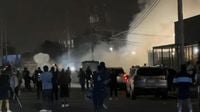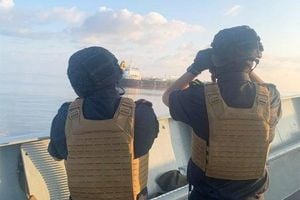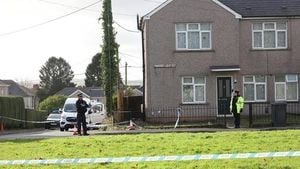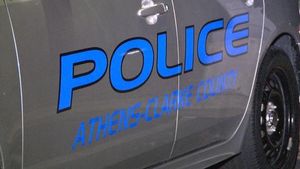On September 19, 2025, the usually quiet suburb of Broadview, just west of Chicago, became the epicenter of a fierce and emotional standoff between federal immigration authorities and hundreds of protesters. The crowd gathered outside the Broadview Immigration and Customs Enforcement (ICE) detention center, a place that has come to symbolize the Trump administration’s intensified immigration crackdown, known as Operation Midway Blitz. The operation, which has swept through Illinois with a heavy federal presence, has led to more than 550 undocumented immigrants being detained in just two weeks, ICE officials told NBC 5 Investigates.
The protest wasn’t just another Friday demonstration. Tensions had been simmering for weeks, with smaller rallies every Friday, but this time, the stakes felt higher. Outrage had been mounting since the fatal shooting of Silverio Villegas-González, a restaurant cook, during a traffic stop in Franklin Park on September 12. Many protesters cited this tragedy as a catalyst for their activism, seeing it as the latest example of what they called "escalating state violence." According to South Side Weekly, many of those arrested in recent weeks had no criminal records, removal orders, or even scheduled appointments—some were simply picked up during routine traffic stops or in public spaces.
Friday’s protest began early, with Bushra Amiwala, a Democratic candidate for Congress in Illinois’ 9th District, arriving at 7:15 a.m. By 8:30, the situation had escalated. Amiwala described the moment when protesters locked arms to prevent an ICE van from leaving the facility: "Around 8:30, when an ICE van was trying to leave the premises, dozens of peaceful protesters and I locked arms to prevent this vehicle from leaving." The response from ICE agents was immediate and forceful. "The ICE agents from the roof let out tear gas, pellet bullets, and pepper spray," Amiwala told South Side Weekly.
She recounted the chaos that followed: "I was directly in front of the vehicle as it drove into us. All the protestors had to break with intense difficulty to breathe, and pain, burning, and stinging sensation in my eyes and on my skin." The line of protesters broke apart as people gasped for air, their eyes burning from the chemical agents. Amiwala, who has spent months organizing against ICE and educating small business owners about legal rights during raids, found herself in the thick of the violence. "My eyes were full of pepper spray. It was hard to breathe," she said.
As the day wore on, the protest swelled, drawing in more demonstrators, organizers, and even religious leaders. Kelly Hayes, an organizer, author, and educator, arrived that evening after seeing disturbing images of the morning’s violence on social media. "Within moments of arriving, I saw a man shot in the head with a pepper ball," she told South Side Weekly. The man had been standing on the sidewalk, appealing to the humanity of agents on the roof, when he was struck. "What I saw on social media didn’t prepare me for the intensity of Friday night’s violence," Hayes admitted.
Religious leaders were not spared. In a widely circulated video, Reverend David Black of First Presbyterian Church was seen pleading with agents on the roof to stop detaining migrants. Within minutes, he was struck in the head with a pepper ball, staggering back as others rushed to help him. Hayes described the scene: "They filled the street with tear gas, charged the crowd multiple times, only once were they ensuring the passage of a vehicle. Every other time they exited the walls and fences of that facility to attack people." Amid the chaos, Hayes found herself tending to the injured: "I flushed the eyes of a man who was hit in the forehead with a pepper ball while standing next to me."
Despite the violence, Hayes was struck by the solidarity among protesters. "The defiance and love that people embodied that night are a symbol of our values. We love our stolen neighbors and we want them back." According to the Sun-Times, ten protesters were arrested during Friday’s protest, though the Department of Homeland Security (DHS) later reported at least 16 arrests at the facility so far, with at least 10 released, as noted by the National Lawyers Guild.
The federal response was unapologetic. Tricia McLaughlin, assistant secretary for public affairs at DHS, issued a statement: "Any allegations that ICE Broadview Processing Center is temporarily closing are FALSE." She accused demonstrators of throwing tear gas cans, rocks, bottles, and fireworks at law enforcement, slashing car tires, and blocking entrances. "Secretary Noem’s message to rioters is clear: you will not stop us or slow us down. ICE will continue to enforce the law. And if you lay a hand on a law enforcement officer, you will be prosecuted to the fullest extent of the law," McLaughlin said.
The National Lawyers Guild countered with allegations of excessive force. "The violent use of government power to suppress dissent embodies the authoritarian and xenophobic agenda being pursued by federal authorities," Brad Thomson, a volunteer attorney with NLG Chicago, said in a statement. The Guild reported that agents appeared to "fire projectiles directly at individuals, including at their heads," with at least two people hospitalized.
The Department of Homeland Security, meanwhile, accused the state of Illinois of refusing to assist due to sanctuary city policies. Governor J.B. Pritzker’s office pushed back, saying, "It’s completely false to suggest the state or local municipalities have been obstructing federal officials. The state has not received multiple calls for assistance from the federal government and would remind them the importance of coordinating with local law enforcement to protect public safety." Pritzker’s office also emphasized, "Governor Pritzker has been clear that violence is unacceptable and everyone needs to follow the law, which includes federal agents respecting constitutional rights to peaceful protest." The village of Broadview and Cook County, according to the governor’s office, had not requested state help.
The violence was not limited to activists. Kat Abughazaleh, another candidate for Congress in Illinois’ 9th District, was thrown to the ground by federal agents. "What’s really important to mention here, I’m gonna have a bruise on my side, but that doesn’t hold a candle to the people trapped in the facility are dealing with," Abughazaleh told NBC Chicago. Even journalists were caught in the crossfire. NBC Chicago reporter Jenn Schanz reported, "We just got sprayed with -- I don’t know if it was tear gas, or pepper spray -- I know it stung my eyes. It was very hard to breathe." A photo captured by NBC Chicago photographer George Mycyk showed a bottle marked "riot control" that had been sprayed at protesters.
As the dust settled, the Broadview ICE facility remained open, with federal authorities vowing to continue their enforcement efforts. For protesters, the events of September 19 became a rallying cry—a testament to their resilience and a stark reminder of the human cost of immigration enforcement. The story of Broadview, with its tear gas, pepper balls, and cries for justice, is far from over.




